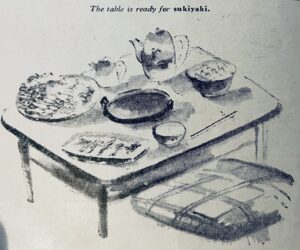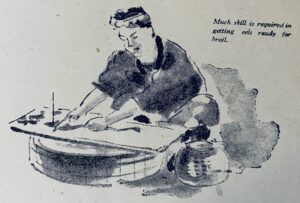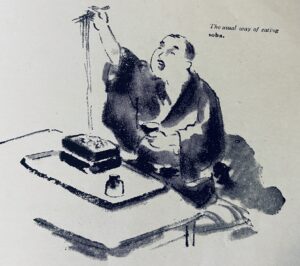 I picked up a cheap copy of an old 19461 tourist pamphlet Notes on Japanese Cuisine by Katsumata Senkichirō (勝俣銓吉郎). I’ve scanned my copy and uploaded it to the Internet Archive here.2 The pamphlet pops up in at least two recent works by Eric C. Rath: in his afterward to Devouring Japan: Global Perspectives on Japanese Culinary Identity and his new 2021 Oishii: The History of Sushi. In the latter, Rath highlights one of the points that also first struck me when skimming Notes on Japanese Cuisine the first time: that it celebrates sukiyaki as Japan’s ‘national dish’.3 “Sushi (Fancy Rice Balls)”, the last entry in the pamphlet, is introduced as the final boss to beat in the game:
I picked up a cheap copy of an old 19461 tourist pamphlet Notes on Japanese Cuisine by Katsumata Senkichirō (勝俣銓吉郎). I’ve scanned my copy and uploaded it to the Internet Archive here.2 The pamphlet pops up in at least two recent works by Eric C. Rath: in his afterward to Devouring Japan: Global Perspectives on Japanese Culinary Identity and his new 2021 Oishii: The History of Sushi. In the latter, Rath highlights one of the points that also first struck me when skimming Notes on Japanese Cuisine the first time: that it celebrates sukiyaki as Japan’s ‘national dish’.3 “Sushi (Fancy Rice Balls)”, the last entry in the pamphlet, is introduced as the final boss to beat in the game:
Along the safe lines of approach are—sukiyaki, kabayaki, tempura, and soba. When these Japanese delicacies appreciable even to the exclusively European palate have been tried with success, the explorer is in a position to penetrate deeper from this borderland into the realm of the strange. What next? The voice of experience will whisper to him—sushi.
 This is a fun little pamphlet to explore. Most of Katsumata’s extensive career of publications, including his 1901 collection and translation of humorous English language anecdotes to his role as editor of the 1954 edition of Kenkyūsha’s New Japanese-English Dictionary were related to English language learning and it is on show in the pleasant, if occasionaly hyperbolic, prose of the pamphlet, which offers a “rough charting of the sea of taste” in Japan. The rough waters are generated, at least in two sections, by the tension between “Tokyo” (Kantō) and “Kansai styles”4 of various dishes described, with those favouring the former sometimes given more voice their their claims to authenticity than the latter, e.g., “[the conclusion of those who favour the Tōkyō style of “sukiyaki”] is that the Kansai style may have fair claim to good economy, but that the Tōkyō style is the true way of a genuine lover of delicate taste…”5
This is a fun little pamphlet to explore. Most of Katsumata’s extensive career of publications, including his 1901 collection and translation of humorous English language anecdotes to his role as editor of the 1954 edition of Kenkyūsha’s New Japanese-English Dictionary were related to English language learning and it is on show in the pleasant, if occasionaly hyperbolic, prose of the pamphlet, which offers a “rough charting of the sea of taste” in Japan. The rough waters are generated, at least in two sections, by the tension between “Tokyo” (Kantō) and “Kansai styles”4 of various dishes described, with those favouring the former sometimes given more voice their their claims to authenticity than the latter, e.g., “[the conclusion of those who favour the Tōkyō style of “sukiyaki”] is that the Kansai style may have fair claim to good economy, but that the Tōkyō style is the true way of a genuine lover of delicate taste…”5
 The most passionate language in the pamphlet is found in the section on soba or “Buckwheat macaroni”, Japan’s “food for the people.”6 The crop of buckwheat itself is described as having “a queer destiny of receding before the advance of civilization,” shifting over time and “follow[ing the] Ainu in its northward retreat from developing culture” and ending up in the “backward provinces” on the “shady side of Hokkaido”7 This “retreat” north of buckwheat is given an unusual amount of space and at once replicates a standard narrative of combined civilizational progress and northern conquest, but then pivots to celebrate its use: praising its more “primitive” milling methods and its rich nutritional content, or highlighting its deep connection to the Japanese people. “A public bath and a soba shop are the earliest suppliers of wants that come into being in a developing Japanese community; so intimately is soba interwoven with our life.”8
The most passionate language in the pamphlet is found in the section on soba or “Buckwheat macaroni”, Japan’s “food for the people.”6 The crop of buckwheat itself is described as having “a queer destiny of receding before the advance of civilization,” shifting over time and “follow[ing the] Ainu in its northward retreat from developing culture” and ending up in the “backward provinces” on the “shady side of Hokkaido”7 This “retreat” north of buckwheat is given an unusual amount of space and at once replicates a standard narrative of combined civilizational progress and northern conquest, but then pivots to celebrate its use: praising its more “primitive” milling methods and its rich nutritional content, or highlighting its deep connection to the Japanese people. “A public bath and a soba shop are the earliest suppliers of wants that come into being in a developing Japanese community; so intimately is soba interwoven with our life.”8
Of the various foods discussed in the book, it is interesting to note that the only lines connecting Japanese cuisine to the world beyond the archipelago are found in the second to last paragraph of the pamphlet, concluding the section on sushi:
It is on record that the heroic Empress Jingū had sushi among the provisions for her expedition against Korea some seventeen centuries ago. Sushi in those old days, however, was preserved fish, or, rarely, meat, pickled not in vinegar but by preservation in salt for a long time. The original idea of the present form of sushi is said to have been brought from China by people who were sent out amity, commerce, or intellectual pursuits…9
See Eric Rath’s new work on the history of sushi for a more extensive discussion of these origin tales, but most interesting to me is that this was what Katsumata decided to go with for the conclusion of his pamphlet: a nod to Chinese connections. Was this part of a likely earlier 1935 edition of the pamphlet, or something new added in 1946, one might wonder. This is followed by the final sentence of the pamphlet, which doesn’t exactly leave one with the image of sushi as the pinnacle of refinement: “Sushi is now widely used for convenience of handling in garden parties, athletic meets, and picnics.”
Nothing in the pamphlet is said, of course, of the most fascinating transnational culinary characters in Japanese history. In 2016 I was invited by our university’s student-run Japan Society to give a short talk on the history of Japanese food. I protested that I was knew nothing about the history of food in general, and not much more on Japanese food history, in particular. No matter, they assured me, just come and tell us a few interesting things about your favorite Japanese foods, and in exchange they would prepare exmaples of these dishes for everyone to try. So I replied that I could offer some historical background notes associated with the first edibles I was introduced to by my host family on my first trip to Japan, when I spent a wonderful summer homestay volunteering at a kindergarten in the countryside outside of Tateyama, on the Bōsō peninsula in 1995: korokke (paired with something), ramen, and Japanese curry.
Clearly, my hosts correctly judged their new arrival as anything but ready to penetrate into “the realm of the strange”, but the “borderland” to that realm I was first exposed to was not the one Katsumata was referring to in the form of sukiyaki and soba, but rather the borderland between Japan and its historic culinary interlocutors. None of these three, which all have their origins outside of Japan, were likely to be what the students had in mind, but the latter two, ramen and curry especially, have particularly rich culinary histories in Japan, and are still my two favorite things to eat in Japan today. To be honest, and forgive this blasphemy, I would still choose a cheap but delicious bowl of udon or soba with a nice crispy korokke, consumed standing (立食い) on the platform of some station over the most delicious sushi in Japan. Platform noodles were apparently already common when Katsumata wrote his pamphlet in the 1930s or 1946: he refers to “station buffets” that sell soba to passengers who “desire to snatch a quick lunch during the short stay of their train at the station”. My preference for a bowl of noodles and a potato croquette is obviously revealing: it is not you, sushi, it’s me! It is just the kind of carbs with carbs definitely-not-slow-food barbarian I was raised to be, taking my meals through life as I change trains from one task to another.
A work by the same title, with Japan Travel Bureau as the author, is listed in the Japan, the New Official Guide (1941) p832 as a work published in 1935, which overlaps the period when Katzumata was, acccording to an autobiographical article (「私の歩んだ道」) by him, writing essays for the JTB. If a copy of the earlier 1930s edition is out there, it would be interesting to see what didn’t pass the SCAP censors for publication in a Japan under US occupation in 1946. ↩
It should be out of copyright as of 2009. ↩
Eric C. Rath Oishii: The History of Sushi, p139. Katsumata, Notes on Japanese Cuisine, p2. ↩
in the case of Kabayaki, “lake Hamana seems to be the dividing line of the two different styles”, p7. ↩
p4. ↩
p14. ↩
p16. ↩
p21. ↩
p24. ↩